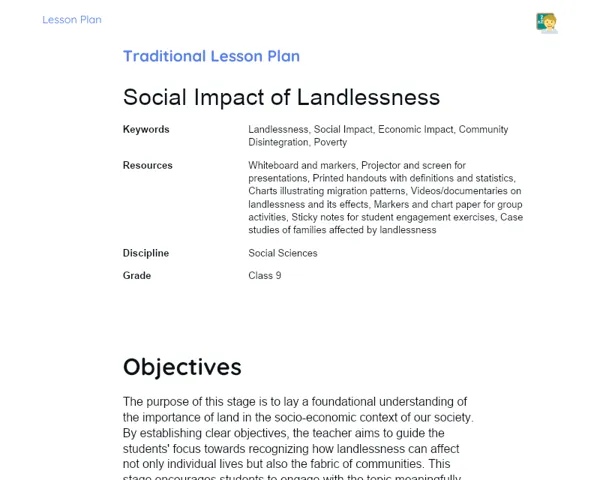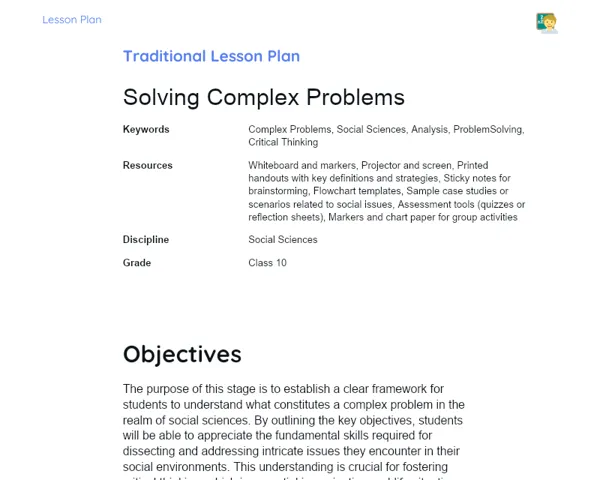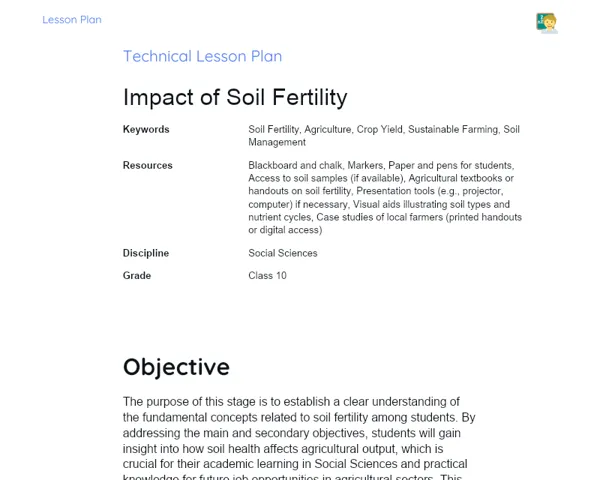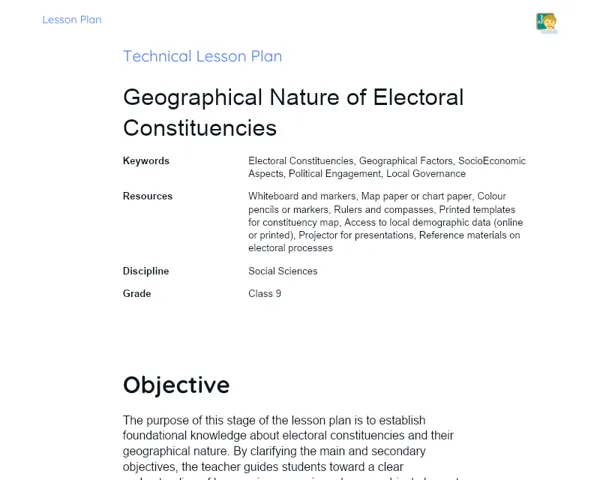Lesson Plan | Traditional Lesson Plan | Economic Dependence of Regions
| Keywords | Economic Dependence, Natural Resources, Trade, Regions of India, Interdependence, Local Economies, Real-life Examples, Cultural Connections, Student Engagement, Critical Thinking |
| Resources | Chalkboard and chalk, Markers and chart paper, Maps of India highlighting different regions, Pictures of local products from various states, Printed handouts with questions for discussion, Projector for visual aids (if available), Whiteboard for summarizing key points, Student notebooks for note-taking, Examples of local dishes and their ingredients, Small rewards for participating in discussions (like stickers) |
Objectives
Duration: (10 - 15 minutes)
The purpose of this stage is to set a clear foundation for the lesson by outlining the goals that students are expected to achieve. By identifying the main objectives, students will have a focused understanding of what they will learn about economic dependence and trade in the context of various regions in India. This will create a roadmap for their learning journey, allowing them to connect the dots as they progress through the lecture.
Main Objectives:
1. To enable students to identify and describe the various natural resources available in different regions of India.
2. To help students understand the concept of trade and how it influences economic dependencies between regions.
3. To encourage students to analyze real-life examples of regions within India that demonstrate economic interdependence.
Introduction
Duration: (10 - 15 minutes)
The purpose of this stage is to engage students right from the start by providing them with a relatable context and an intriguing fact that highlights the significance of economic dependencies. This introduction will not only set the tone for the lesson but also stimulate their curiosity and interest in understanding how regions rely on one another economically, paving the way for deeper learning during the lecture.
Did you know?
Did you know that India is the largest producer of milk in the world? That's right! With states like Gujarat leading in dairy farming, milk from these regions is not only consumed locally but also traded with many other states. This trade helps support farmers and influences the economy of both the milk-producing and milk-consuming areas!
Contextualization
The economic dependence of regions is a crucial topic for understanding how different areas contribute to each other's growth and prosperity. In India, each region possesses unique natural resources, cultures, and industries, from the rice fields of Punjab to the mineral wealth of Jharkhand. By examining these economic relationships, students will gain insights into how trade affects their own lives and the communities around them, fostering a greater sense of appreciation for local economies and the interconnectedness of the nation.
Concepts
Duration: (40 - 50 minutes)
The purpose of this development stage is to delve deeper into the essential concepts related to economic dependence, enabling students to grasp the foundational knowledge necessary to understand the relationships between different regions in India. By exploring the relevance of natural resources, the concept of trade, and interdependence, students will learn to appreciate how local economies impact each other. This stage encourages active participation through discussions and questions, fostering a more interactive learning environment.
Relevant Topics
1. Understanding Economic Dependence
2. Natural Resources and their Importance
3. The Concept of Trade and Interdependence among Regions
To Reinforce Learning
1. What are some natural resources found in your region?
2. How do these resources contribute to trade with other regions?
3. Can you think of a way in which your daily life is influenced by trade between different regions?
Feedback
Duration: (15 - 20 minutes)
The purpose of the Feedback stage is to consolidate the students' understanding of the concepts covered during the lecture. By discussing the resolutions to the questions posed earlier, the teacher will reinforce the knowledge acquired and clarify any misunderstandings. Engaging the students with reflective questions will encourage them to think critically about how economic dependencies affect their lives and to connect the theoretical aspects of the lesson to real-world examples. This interactive discussion will solidify their learning and promote a deeper appreciation for regional interdependence.
Concept Discussion
1. Natural resources found in various regions include the fertile soil of Punjab which supports rice and wheat farming, the mineral deposits in Jharkhand, and the fishing resources along the coasts of Kerala and Maharashtra. 2. These resources contribute to trade as they are often transported to other regions where they are in demand. For example, wheat from Punjab is sent to states in need of food supplies, while Gujarat's cotton not only supports local textile industries but is also exported to other regions. 3. Daily life is influenced through various products we consume, such as vegetables from Maharashtra or fruits from Himachal Pradesh. This trade not only supports local economies but also brings diverse products to our markets.
Engaging Students
1. Can you name a local product that comes from a different state? How do you think it reaches your hometown? 2. If you were to trade one item from your home region with another state, what would it be and why? 3. What local dishes do you think depend on ingredients from other regions? Can you identify any dishes that highlight this interdependence?
Conclusion
Duration: (10 - 15 minutes)
The purpose of this conclusion stage is to reinforce the key concepts learned during the lecture and to help students articulate their understanding of economic dependence and trade. By summarizing the main points, connecting them to everyday experiences, and highlighting their relevance, the teacher will create a comprehensive overview that solidifies students' knowledge and stimulates reflection on the economic relationships they encounter in their daily lives.
Summary
['Understanding the concept of economic dependence and its significance in the context of various regions in India.', 'Identifying and describing the natural resources that different regions possess, such as fertile land in Punjab, minerals in Jharkhand, and coastal fishing resources in Kerala.', 'Comprehending the role of trade in facilitating economic relationships among regions, exemplified by the exchange of goods like wheat from Punjab and cotton from Gujarat.', 'Recognizing how daily life is influenced by this trade, leading to an appreciation of the interconnectedness of local economies.']
Connection
Students can relate the lesson to their everyday experiences by recognizing the natural resources available in their own region and how they contribute to local businesses and markets. For instance, if students consume fruits from Himachal Pradesh or spices from Kerala, they can connect these products to the broader economic system that supports their availability, showing how trade enriches their lives and local culture.
Theme Relevance
Understanding economic dependence is important for students as it fosters awareness of how their local economy functions and how various regions support one another. This knowledge helps students become informed citizens, capable of recognizing the value of local resources and the impact of trade on their lives, thereby instilling a sense of pride in their cultural and regional heritage.



